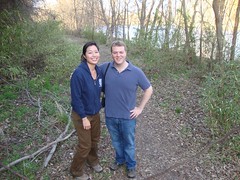A draft of the check-off sheet to be carried by each student on the Coates Bluff nature walk:
Coates Bluff / riparian flora and fauna (riparian refers to the bank of a stream)
__Sycamore: tall tree; peeling bark and large leaves.
__ Cottonwood: one of the largest N Amer hardwood trees. Riverine (usually grows in river bottoms).
__ Water oak: fast-growing, tall bottomland oak that is very important to wildlife.
__ Willow: medicinal bark, extensive root system, used in wood products industry.
__ Hackberry: medium-sized tree important to the lumber industry and to wildlife. The bark is studded with warts.
__ Dogwood: though a small tree, its leaves (ink, dyes) and wood (mallets, tool handles) have long been useful in small industry.
__ Box elder (a type of maple): medium-sized tree of the bottom land.
__ Virginia creeper: a ground cover that inhibits erosion. Medicinal plant - but the berries are poisonous. Similar to poison ivy but has 5 leaflets instead of 3.
__ Muscadine vine: wine or jam is made from tart muscadine grapes. Anti-cancer properties in the grapes.
__ Poison ivy: a noxious weed of which it is said, "Leaves of three, let it be," "Longer middle stem, stay away from them," and "Hairy vine, no friend of mine." It can grow as a shrub or a vine.
Upland growth
__ Hickory: important source of wildlife food; wood is useful in numerous industries (from lumber to smoked meat).
__ Live oak: an evergreen known for its long life and spreading branches; important to wildlife for its acorns and known for strength of its wood.
__ Pine: commercially important for timber and wood pulp. They are fast-growing softwoods that live in the uplands.
Fauna
__ Armadillos: burrowing mammals with a leathery shell that eat insects. Important to scientists.
__ Hawks or falcons: swift birds of prey.
__ Black snake: non-poisonous and hibernating in the winter. They eat rodents, eggs and other snakes.
Smells
__ Loamy (loam is soil composed of clay, silt and sand.) and sandy soil. Decomposing leaves.
Sounds
__ Crows. Hawks. Mockingbirds. Sparrows.
__ Critters escaping though the leaves.
Non-woodsy materials
__ Litter.
__ Fencing, gravestones, etc.
skip to main |
skip to sidebar
For students and parents who love education and exploration of the social sciences . . .
Search This Blog
Followers
Blog Archive
-
▼
2011
(242)
-
▼
February
(21)
- Still need parent chaperones for Coates Bluff Natu...
- African island video, "Leopards of Zanzibar" / Zan...
- The Boy and the Crocodile, a West African fable fr...
- Need parent volunteers to chaperone a Coates Bluff...
- Houston and Kansas City: The Lost Boys of Sudan
- Swahili: a universal language of East Africa
- Refugees and the continent of Africa
- Larry Raymond, conservationist, on the flora and f...
- Magnet geography / Africa: indie work
- K'naan: a Somali singer-songwriter repping East Af...
- Revolution in 2 African / Mediterranean nations th...
- Next quiz: Lawrence of Arabia questions in an open...
- Writer's Workshop on Thurs after school in E 205
- Dinka tribal people and "The Lost Boys of Sudan"
- The continent of africa, continent of Africa: regi...
- Map quiz on Israel and Jerusalem: Dome of the Rock...
- Map quiz next class; see example here
- The Jews and the Jewish nation of Israel and the c...
- Dhow fishing nd trading boats: from the coast of I...
- Lawrence of Arabia and the Bedouins attack the Tur...
- Mid East map quiz next class!
-
▼
February
(21)

